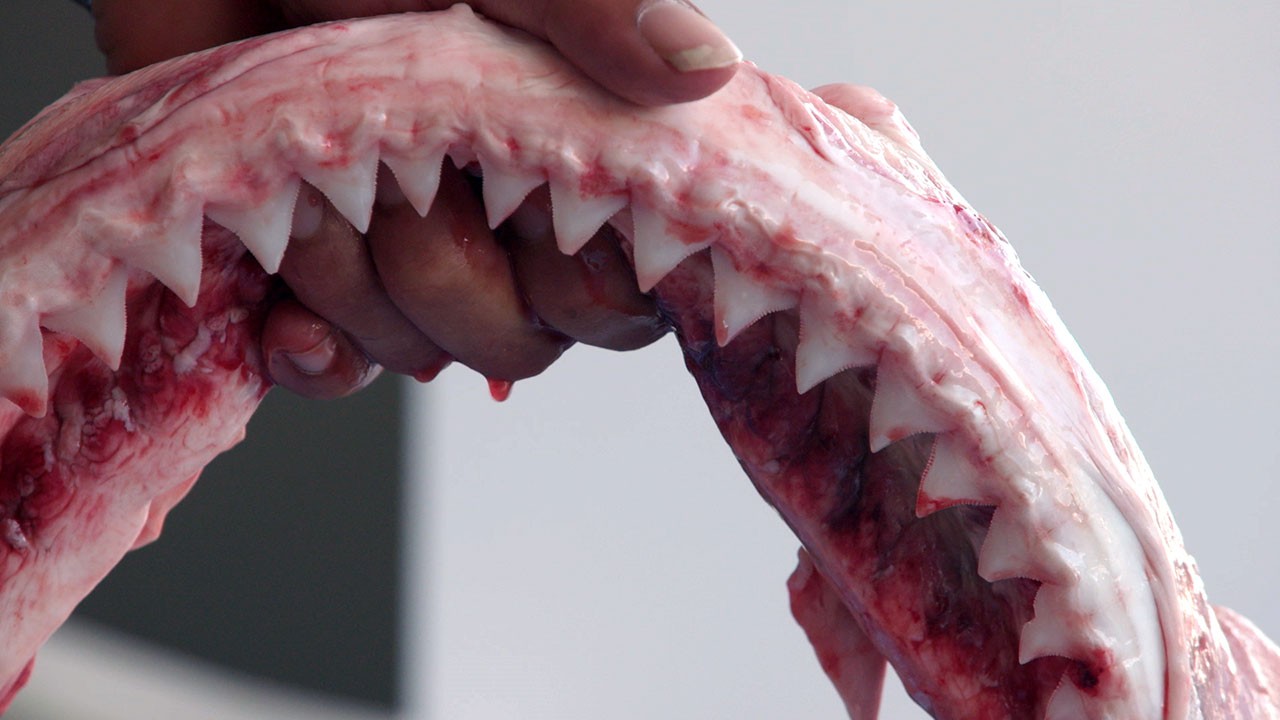Photo by Alma Gehrmann/courtesy of Penguin Random House
Summer
Watch on Motherboard: 'Surrounded: Island of the Sharks':

At last we're going to put out our baited fishing line, five nautical miles south of the Skrova lighthouse. Hugo stays as far away as he can possibly get in our small boat as I cut open the remaining sack of offal from the slaughtered bull. The corpse stench pours out of the bag to hover over Vestfjorden. If we're lucky, we won't have a Greenland shark jumping into the boat while I'm attaching a hip joint covered with rotting red meat to the big, shiny hook. I don't know what sort of expectations the Scottish Highland bull may have had, but I'm pretty sure the animal never imagined anything like this.We make sure we're positioned in exactly the same spot as yesterday when we sank our chum bait to lure the shark. Then I drop the hook over the side. As Rimbaud put it: "Hideous strands at the end of brown gulfs / Where giant serpents devoured by bedbugs / Fall down from gnarled trees with black scent!" I let the chain and the line run down to the bottom, not stopping until the reel is almost empty, which means we've let out close to 1,100 feet of line. The 20 feet of chain at the bottom are essential because if the Greenland shark bites, it will start to roll around. The skin of the shark is so rough that a chain is the only thing that will hold. If you were to stroke a Greenland shark away from the direction it swims, its skin would feel smooth and frictionless. But if you stroke it in the opposite direction, you would cut your hand badly, because the shark's skin is covered with tiny "skin teeth," sharp as razors. Before World War II, Greenland sharks were exported to Germany, where the skin was used for sandpaper. The liver of the shark was boiled, and the fat was used in the production of glycerin and nitroglycerin. The latter, a highly unstable explosive, would often go off accidentally when sparked by small shocks or friction, and kill the people who handled or transported it.
The Greenland shark. Illustration by Nicholas Gazin
The Greenland shark can be used for more than just making sandpaper and nitroglycerin. Its flesh is poisonous, smells like urine, and can serve as a potent drug. The Inuit used to feed the meat to their dogs, if nothing else was available. But the dogs would get extremely intoxicated and might even end up paralyzed for days. During World War I, there was a shortage of food in many places in the north, and people couldn't be choosy.Have you ever tried to haul up from the sea floor a Greenland shark that's maybe 22 feet long and weighs 1,500 pounds? A shark that's holding on to an 1,100-foot line attached to 20 feet of chain?
If people ate the meat when it was fresh, or neglected to treat it in the proper way, they could get "shark drunk," an inebriated state that is supposedly similar to taking in an extreme amount of alcohol or hallucinogenic drugs.
Watch VICE Meets Norwegian literary sensation Karl Ove Knausgaard:

Hugo tells me that something similar was done with basking sharks. It was common to turn the shark over and cut open the belly so the liver floated out. Then the shark would continue swimming without its liver, at least for a while.They didn't always cut off the tail of a Greenland shark. My friend the trawler seaman told me that sometimes they also painted the name of their boat on the side of the shark, as a greeting to the next trawler that happened to catch it. Whoever landed a shark like that in their net would paint the name of their own trawler on the other side of the fish and then set it free again. It probably would have been easier to send a postcard, but trawler crews have their own brand of humor."Look! Isn't the float moving?" Hugo says. It looks like it's popping up and down with the unnatural rhythm of a gigantic fishing bob. Something is definitely happening a few hundred yards away from where we're sitting, in the middle of a shoal of mackerel. Hugo starts the motor, and in 60 seconds we're at the site.Hugo starts pulling up, meaning he hauls on the line, and there's no doubt that something big has taken the bait. After a while I take over, and it goes even slower. Have you ever tried to haul up from the sea floor a Greenland shark that's maybe 22 feet long and weighs 1,500 pounds? A shark that's holding on to an 1,100-foot line attached to 20 feet of chain? The line digs into my fingers. It's sheer agony. Stinging jellyfish have attached themselves to the line, and we're not wearing gloves.
We can clearly see the sawlike marks left by the shark's teeth on the bone and fat. The hook is stuck through a tendon in the joint so it lies right next to the bone. I had assumed the shark would crush the whole thing if it took the bait. But it didn't. And that's why the shark wasn't hooked more firmly. That's why it was able to pull free or simply let go. That's why we're sitting here, not saying a word. I tell Hugo about my mistake, and he just gives me a pensive little nod without a hint of blame.Down there, underneath our pontoons, our monster is swimming, waiting to be fed.
We get no more bites that day. Or the next. On the third day we let the baited line stay out there all night. The following morning the whole thing is gone, as if sunk into the sea. Both floats are probably far out in the ocean, dragged off by some invisible force, either by the current or by a Greenland shark. It would be pointless to go looking for the floats. Even if we had all the time in the world and an unlimited supply of gasoline, the chance of finding them would be close to zero.Three days later we're on our way back across Vestfjorden. We've written off the floats and chain, along with the fishing line. But out in the middle of Vestfjorden, in poor visibility and high seas, we practically run right into them. The whole length of line and chain is there. Only the hook and shackle, the U-shaped steel clamp fastening the hook to the chain, is missing. That's incredible. It shouldn't be possible for a clamp, firmly fastened with a pair of pliers, to come loose. And it would take tremendous force to snap it in two. Yet one of these two things must have happened. At least that's what we tell ourselves. But the truth is, it was amateurish for us to leave the baited line out here overnight. Local fishermen confirm this. The current is so strong that it will take everything, if given enough time.
Our boat carves a white V across Vestfjorden. Out in the ocean a small rainbow forms a portal. It's tempting to set course toward it, just to drive through. But we're not hunting rainbows.The mirage line, where the sky meets the sea, is suddenly obscured, creating optical illusions. Several small islands out there seem to be much closer, floating above the glittering sea. The sun is burning the edges of magnesium-white clouds far to the west. It has rained, and we can see individually delineated local showers pouring down way off in the distance. The sun isn't visible to us, but it casts its light around and in between the rain, in some places looking like gigantic spotlights slowly sweeping across the surface of the water. Where we are, the world seems cleansed and filled with mirrors. The colors are oyster shell and slate.Translated from the Norwegian by Tiina Nunnally.From SHARK DRUNK: THE ART OF CATCHING A LARGE SHARK FROM A TINY RUBBER DINGHY IN A BIG OCEAN by Morten Strøksnes. Published by arrangement with Knopf, an imprint of the Knopf Doubleday Publishing Group, a division of Penguin Random House LLC. Copyright © 2017 by Morten Strøksnes.
